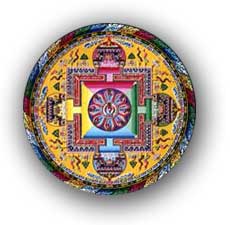Music, art play role in monks' spirituality
By Dolores Tropiano, The Arizona Republic, October 19, 2006
Scottsdale, AZ (USA) -- It has been said that math feeds the mind and the arts feed the soul. If that's true, the Drepung Loseling monks will have a regular feast of both this week.
 The exiled monks will chant and dance Friday before a sold-out crowd at the Scottsdale Center for the Performing Arts as part of their nationwide tour, Mystical Arts of Tibet: Sacred Music Sacred Dance.
The exiled monks will chant and dance Friday before a sold-out crowd at the Scottsdale Center for the Performing Arts as part of their nationwide tour, Mystical Arts of Tibet: Sacred Music Sacred Dance.
The nine monks, from a monastery in southern India, perform what is known as multiphonic singing, a kind of sophisticated chant in which the monks simultaneously intone three notes of one chord.
"The dancing represents the external, internal and subtle elements of enlightenment, with different gestures and movements synchronized to music," said Tsepak Rigzin, translator for the group.
The monks are creating a mandala, a sand painting that symbolizes the transient nature of all things. They'll work on the painting through Sunday.
The process of creating the mandala began Tuesday with a ceremony that included a blessing to cleanse the environment.
Mandala making is an ancient tradition of Tantric Buddhism. It involves painting with colored sand, placing millions of grains on a flat platform over several days to form an image.
"The mandala is meditation in the form of art," Rigzin said.
The finished product includes geometric shapes and ancient spiritual symbols. Each mandala expresses the special energy of a different Buddha.
"It represents an advanced level of the human mind expressed in the form of art," Rigzin said.
A version of this story may have appeared in your community section or your community Republic.
About the monastery
Drepung Monastery was established near Lhasa, Tibet, in 1416.
It had four departments. Loseling, or "The Hermitage of the Radiant Mind," was the largest, housing more than three-quarters of Drepung's 10,000 to 15,000 monks.
Drepung Loseling was especially close to the Dalai Lama incarnations. The Second Dalai Lama made his residence here in 1494, and subsequent incarnations maintained this link.
After the Chinese Communist invasion of Tibet in 1959 and the forced closure and destruction of Tibet's 6,500 monasteries, about 250 monks from Loseling managed to escape the holocaust and rebuild their institution in Karnataka, India.
The training program was preserved.
Other spiritual aspirants have fled Chinese-occupied Tibet and sought entrance into the monastery, thus helping to preserve traditional culture. The number of monks in the re-established Drepung Loseling has increased to more than 2,500.

 The exiled monks will chant and dance Friday before a sold-out crowd at the Scottsdale Center for the Performing Arts as part of their nationwide tour, Mystical Arts of Tibet: Sacred Music Sacred Dance.
The exiled monks will chant and dance Friday before a sold-out crowd at the Scottsdale Center for the Performing Arts as part of their nationwide tour, Mystical Arts of Tibet: Sacred Music Sacred Dance.